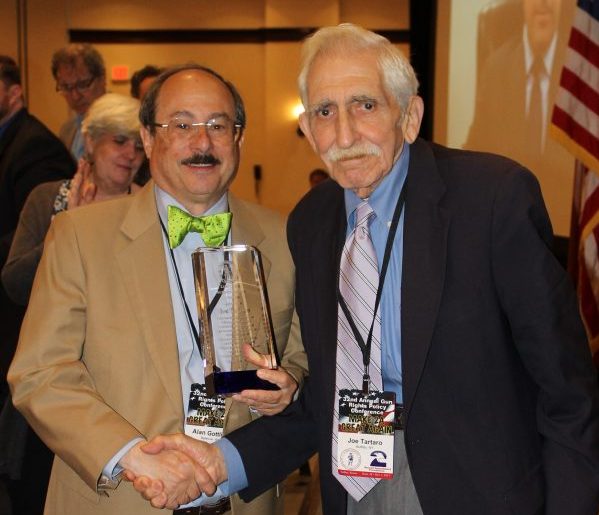
Alan Gottlieb presents TGM Executive Editor Joe Tartaro with a Lifetime Achievement Award. (Dave Workman)
by Dave Workman | Senior Editor
Hours before he was honored by the Second Amendment Foundation with a Lifetime Achievement Award, SAF President Joe Tartaro told a large audience at the 32nd annual Gun Rights Policy Conference in Dallas on Sept. 30 that in order to “make the Second Amendment great again,” gun owners need to roll up their sleeves and go on the offensive.
“We need activism like we’ve never had it before,” Tartaro declared. “The big question is: will you do it?”
The audience of several hundred gun rights activists from across the map responded with a resounding “Yes!”
It was the opening salvo in a conference that saw 84 speakers on dozens of panels dealing with every facet of the gun rights movement, from politics to community outreach toward gays and minorities. The underlying theme of the entire conference was that this is not the time to fold up tents and go home after declaring victory with Donald Trump in the White House.
“Right now at the federal level,” Tartaro said, “we have the greatest opportunity to make strides. But the clock is already running down. This has to happen in the next 12 months.”
High on the agenda are national concealed carry reciprocity and the Hearing Protection Act. There are other items on the agenda, including restoration of funding for “Relief from Disabilities” investigations by the Bureau of Alcohol, Tobacco, Firearms and Explosives. There’s the proposed Second Amendment Guarantee Act, too.
As SAF Executive Vice President Alan M. Gottlieb, who followed Tartaro to the podium, noted, “Having Trump in the White House has been an unbelievable plus.” But that doesn’t mean any of this is going to be easy, he cautioned.
Gottlieb noted that the SAF Judicial Accountability Project appears to be having some positive impact on the selection of new federal judges. Noting that President Trump has the opportunity to fill about 38 percent of the federal bench thanks to all the existing vacancies, he said that a 38 percent shift in the courts would be “an unbelievable boost to our rights.”
“We cannot squander that opportunity,” he cautioned.
Quite possibly the biggest single threat to American gun rights is anti-gun billionaire Michael Bloomberg. He has already announced his intention to spend at least $25 million to defeat national reciprocity, Gottlieb said. He is pouring more money into efforts by anti-gun big city mayors to erode gun rights, and his support for the gun prohibition lobbying groups Everytown for Gun Safety and Moms Demand Acton for Gun Sense in America is a matter of record.
However, Gottlieb observed, “The biggest problem we face is gun owner apathy. This is really unfortunate because now is our chance to move the ball forward.”
NRA Board Members
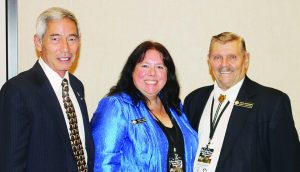
NRA Board Members, L to R, Willes Lee, Linda Walker and John Cushman.
That notion was reinforced by the first panel of the conference. Three members of the National Rifle Association Board of Directors uniformly relayed to the audience that now is the time for action.
Veteran NRA Director John Cushman reminded the crowd that they are “the grassroots.” He warned them to keep an eye out for legislation aimed at so-called “safe storage” and other efforts to micro-manage individual rights.
His colleague, Linda Walker, also told the audience that “now is not the time to be apathetic.”
“We have a historic opportunity to advance Second Amendment rights,” she stated, reminding the room that “Hillary lost.”
“I encourage you all to be involved in the upcoming election,” Walker said.
Willes Lee, who lives in Hawaii, confirmed that national reciprocity is a primary goal this year. The Hearing Protection Act has been “rolled into” the Sportsman’s Act, but after the Las Vegas attack, there was word that the legislation had been shelved, at least for the time being.
This panel was followed by a federal affairs briefing that included panelists Jeff Knox with the Firearms Coalition, Larry Pratt from Gun Owners of America and Joe Waldron with the Citizens Committee for the Right to Keep and Bear Arms.
Knox discussed the SHARE Act, known also as the Sportsman’s Act of 2017, which includes the Hearing Protection Act. He encouraged people to contact their congressional representative to get the bill out of the House.
“We need to push that relentlessly,” Knox said.
He warned that if the House GOP leadership does not move on the legislation, Republicans “are probably not going to enjoy gun owner support at the next election.”
Pratt observed that Republicans are “feckless,” by giving speeches but showing very little movement on bills important to gun owners. He pointed to the special election in Alabama in September where Roy Moore won despite establishment support for his opponent.
But Pratt also noted that modern technology has allowed gun rights groups to remain in contact with their members, and in turn, for the public to contact members of Congress.
“Numbers count,” he said, “and those emails are making a difference. The same old, same old isn’t working. We’re onto them.”
Waldron reminded conferees that there are more than 80 million gun owners but only a few million who belong to organizations such as the NRA, SAF, GOA or the CCRKBA.
He said that the biggest job of lobbyists is to educate people, and that most politicians “need to be educated.” Waldron told activists to make anti-gun lawmakers explain why they are voting against gun rights.
“Communicate, and communicate often,” he advised.
State Legislation
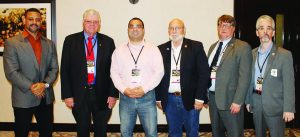
First state legislative panelists, L to-R, Craig DeLuz, Richard Pearson, Alexander Roubian, Jerry Henry, Stephen Aldstadt and Dave Kopp.
The first of two state legislative affairs panels was up next, and the discussion led off with a presentation from Stephen Aldstadt, past president of SCOPE (Shooters Committee on Political Education) in New York. He gave an update on the so-called SAFE Act in New York that has created all kinds of problems for Empire State gun owners.
One of the biggest problems appears to be with the mental health provisions that apparently allow the creation of a “secret” list that amounts to an invasion of privacy and has “no pretense of due process.” The state has had gun licensing for a century and there are more than 50 different licensing administrations.
Dave Kopp, president of the Arizona Citizens Defense League, discussed gun owners who seem to think the fight is over now that Trump is in the White House and Republicans control Congress. The remedy to that lethargy is to “get the people focused on what we’re doing.”
Kopp reported on the efforts to prevent some cities from destroying seized firearms when a 2013 state law prohibits that. The State Supreme Court has ruled that cities must obey that law.
He also noted that money is important to the movement.
“We all need money to function,” he said. “If we’re not supporting, we’re not moving. Michael Bloomberg is right behind us and he’s not going away. We’re the guys in the trenches.”
Alexander Roubian, president of the New Jersey Second Amendment Society, is a believer in “result-oriented activism.” He said the task for activists is to identify the enemy, isolate them by attending public meetings and asking tough questions, and going on the attack.
“Never go on the defensive,” he stressed.
After that, go home, rest and repeat the process, because the battle is not over.
Jerry Henry, executive director of Georgia Carry, offered a brief report on grassroots activities in his state. He noted that campus carry has passed, and that Georgia is now one of the top states for gun rights in the nation.
Like the other speakers, Henry encouraged gun owners to stay active and keep going back to the legislature.
Speaking for the Calguns Foundation, Craig DeLuz made no secret that California is tough territory for gun owners. Over the past three years while the state seems to be releasing more people from jails and prisons, the crime rate has crept upward. Still, the law-abiding citizens are suffering from gun control legislation.
Noting that the Second Amendment is not about hunting or recreational shooting, DeLuz said lawmakers act as though “the Second Amendment is a second-class right.”
“They believe that anyone with a gun is evil,” he stated.
But, he said, gun owners are their own first responders.
Meanwhile, Illinois has more than 2 million gun owners, and they are fighting the influence of Bloomberg in the State Legislature, according to Richard Pearson, executive director of the Illinois State Rifle Association.
This year, Pearson said ISRA “faced almost 100 gun bills, and in 2018, we’ll see another hundred gun bills.” While a lobbyist is the point of a spear, the grassroots is the shaft, he added.
Pearson warned that gun owners “are going to sleep across America,” and this is bad. Membership in major organizations is down, and this is the “prime time to get clobbered.” It is not the time for complacency.
Industry overview
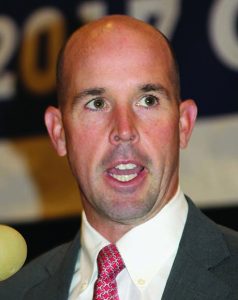
Patrick Rothwell, director, NSSF Government Affairs.
After telling the audience that the so-called “Trump Slump” in firearms sales is being “drastically overplayed” by the media, Patrick Rothwell, director of Government Relations and Federal Affairs for the National Shooting Sports Foundation, said industry is still in better shape than it was one year ago. He added that the firearms industry would not rather have gun sales with Hillary Clinton in the White House.
There have been more than 5,000 bills introduced in the House of Representatives and 270 more in the Senate, but only 83 have passed.
“It is very difficult to get something done in Washington,” he said, “even with Republicans in control.”
However, he said that possibly the biggest win for gun owners was in the appointment of Associated Justice Neil Gorsuch to the Supreme Court.
“That’s a huge win,” Rothwell declared.
In his report, Rothwell also discussed the Pittman-Robertson Federal Aid to Wildlife Restoration program, financed by a special excise tax on firearms and ammunition. Monies from that fund are apportioned to the states for use by natural resource agencies, and if the proposed SHARE Act passes, it might allow a bit more flexibility in the use of those funds, he indicated.
He told the audience to not become discouraged at the pace of politics.
“We have momentum on our side,” he assured.
Second State Report
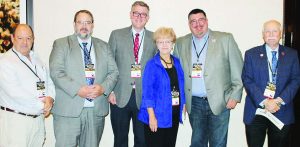
Second state legislative panelists, L to R, Paul Valone, Jim Wallace, Dick Clark, Alice Tripp, Sean Caranna and Philip Van Cleave.
A second panel on state legislative affairs had representatives from Florida, Texas, Virginia, Massachusetts, North Carolina and Nebraska, all with updates on activities in those states.
Alice Tripp, legislative director for the Texas State Rifle and Pistol Association, explained how she lobbies in the Lone Star State. Recalling passage of concealed carry in 2007 and other laws since then, Tripp said the important thing is “be positive.”
“You’ve got to educate yourself,” she said. “If you do your job right, you have no enemies, just people who need to be educated.”
That sentiment was reinforced by Jim Wallace, executive director of the Gun Owners Action League of Massachusetts. He noted that activists who lobby lawmakers have to “be inventive,” and that he frequently confounds anti-gunners by “using their own language against them.”
For example, he has accused the governor of profiling gun owners by supporting certain gun control measures. Among the politically correct, profiling is toxic.
North Carolina’s Paul Valone, founder of Grass Roots North Carolina, warned gun owners about apathy. At a time when many gun owners think there is no threat – such as now with Trump in the White House and the GOP controlling Congress – it is harder to raise money to maintain pro-gun projects.
Valone acknowledged that some gun owners are just tired from battles over the past few years, but it is incumbent upon activists to keep pushing forward. He said it is important to maintain and build an organization’s strength because “another pretext for gun control will happen” and activists will have to fight back. Now is the time to prepare for those challenges.
Philip Van Cleave, president of the Virginia Citizens Defense League, said his group is working hard to double its membership.
“Now is the time to move the ball forward,” he said.
The state’s anti-gun Gov. Terry McAuliffe is on his way out of office, and the campaign to elect a replacement is under way. Van Cleave encouraged activists to stay involved and not let down their guard.
Dick Clark with the Nebraska Firearms Owners’ Association said his group is fighting bad gun laws and proposals, such as doubling the fee for gun permits. He said there is a “major push-back” on preemption, but that his group is “moving the needle in the right direction.”
The anti-gun sentiment in Omaha is a problem, he said.
Sean Caranna, co-founder and co-executive director of Florida Carry, Inc., told the audience that anti-gun politicians should be held accountable. He also said gun owners need to support lawmakers who “carry the water” for gun rights.
He said that often the best laws are the shortest.
One problem in the Sunshine State is that the courts have ruled against open carry, he noted. Earlier this year, the state Supreme Court ruled that the state ban on open carry was constitutional.
Defense Distributed

Cody Wilson, president, Defense Distributed.
One treat on the program was a short presentation by Cody Wilson, president of Defense Distributed and co-developer of the 3D printed “Liberator” firearm. He briefed the audience about the latest developments in the digital manufacturing of so-called “ghost guns.” His company sells a machine called the “Ghost Gunner.” There was one on display at the conference.
Wilson recalled his troubles related to the development of 3D printing technology, and how the government would not allow him to post information about that on the Internet. He maintains that blueprints and other information should be available, but the federal government is using an international treaty to prevent that.
But this technology will enable people to make their own firearms, and Wilson is optimistic that his effort will prevail. However, he declined to predict how his legal efforts will pan out.
He assured the audience that 3D printing is not “a gimmick.” In the years since work began, Wilson said all kinds of materials have become available.
The Second Amendment Foundation has taken up Wilson’s cause and taken it through the courts. At the time of his appearance, the case had gone to the Supreme Court.
The reaction from states has been sporadic, he indicated, adding that the City of Philadelphia has outlawed manufacture of 3D guns.
“The digital revolution has afforded us a set of tools that allows us to do things that the law is not adjusted for,” he observed. “I’m not saying that it should adjust for it.”
Explaining that the gun control act does not regulate the printing of 3D arms, Wilson said anti-gunners want there to be a way to stop this effort. He asserted that the establishment is in a “full on panic” about this technology.
Media and Gun Rights
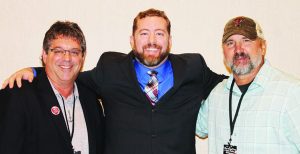
Media perspective, L to R, Mark Walters, Steven Gutowski and AWR Hawkins.
A three-man panel took on the subject of the gun rights battle from a media perspective. Radio host Mark Walters of Armed American Radio led the presentation by bluntly stating, “I hate the media.”
Walters said the mainstream media sets the narrative of the news, and that “they hate everyone in this room,” referring to the conference attendees.
“They’re everywhere and they don’t like you,” he observed.
But he also admonished gun owners for becoming lethargic over the past nine months.
“There are too many of us out there who think ‘Trump won, we’re safe,’” Walters said.
He encouraged people to “fight back” against media dishonesty about firearms, and to “make your voice be heard.
Steve Gutowski, a writer with the Washington Free Beacon, focused on the controversy surrounding broadcast journalist Katie Couric and her program about gun rights and gun control in Virginia. That’s the program that brought a lawsuit against Couric by Virginia activists for allegedly misrepresenting their reaction to a gun control question.
Gutowski said journalists need to do original stories and get them right; “stories that aren’t being told.”
He suggested getting acquainted with local reporters and politely showing them where they might be making mistakes.
AWR Hawkins, a writer for Breitbart News, said gun owners need to push back and not back down. He suggested that one part of the problem is that the media has “ripped God out of the” Declaration of Independence.
“Without a Creator,” he said, “there are no rights, there are privileges,” asserting that the government has no say over his rights.
Suicide Prevention

Prof. Jennifer Stuber.
Another special feature of this year’s conference was a presentation on preventing gun-related suicides by Prof. Jennifer Stuber from the University of Washington Department of Public Health Policy and founder of ForeFront. Stuber has been working on a suicide prevention pilot project in Washington State with SAF’s Alan Gottlieb.
She reported that one in five people will, at some time in their lives, experience some sort of “mental health challenge.” Her late husband passed a background check but took his own life with a firearm, she recalled.
Calling suicide a “silent epidemic,” Stuber said that more people are lost to suicide than die in traffic accidents, among them military veterans who are being lost on an average of 22 each day. She also said middle aged men are another high risk category.
She dispelled a couple of myths, including that if someone is determined to commit suicide nothing can be done to stop it. It’s not that people want to die, she explained, they want relief from their emotional pain.
“They need someone to show them that they care,” Stuber said.
She also said that people who may choose a firearm as their method of suicide can be prevented from acting if the gun is temporarily removed from their access.
“Once the firearm is invisible,” she said, “people can get through it.”
Stuber declared that suicide is preventable, and that’s what the pilot project in Washington is all about. She has turned her anger about suicide into action, and she stressed that suicide is a community problem that everyone can help fix.
Global Gun Grabbers
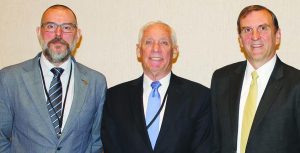
Discussing the Global Gun Grabbers were, L to R, Tomasz Stepien, president and CEO, Firearms United Global; Maj. Gen. Allen Youngman, (ret.), exec, dir., DSAAC, and Rick Patterson, exec. dir., SAAMI.
Rick Patterson, executive director of the Small Arms and Ammunition Manufacturers Institute, led a discussion on global gun control in the wake of the Arms Trade Treaty.
He noted that lead shot is still an issue, asserting that anti-hunters sued the US Fish & Wildlife Service over waterfowl losses back in the 1980s while they allegedly had no evidence that lead shot was a danger to waterfowl.
Patterson also talked about the alleged danger to the California condor from hunters. He maintained that there was no evidence that Condors suffered from lead ingestion, and that lead was a “means to an end,” which is to push for a ban on lead ammunition.
He said anti-hunters want to expand their reach to include other wildlife. Patterson urged hunters and shooters to “get involved.”
Tomas W. Stepien, president and CEO of Firearms United Global, followed Patterson to the podium. He warned that anti-gunners want to make law abiding citizens responsible for the acts of terrorists.
Noting that gun control didn’t prevent the Charlie Hebdo massacre in Paris and that there have been other problems around Europe, which has much tougher gun laws. He said anti-gun billionaires Michael Bloomberg and George Soros have been funding projects that result in anti-gun “studies.” They use their money as a political weapon.
The morning session wrapped with retired Gen. Allen Youngman’s presentation about international gun control. Youngman, executive director of the Defense Small Arms Advisory Committee, recalled some experiences he has had with the press, and also discussed the history of the global gun control movement.
“Facts matter…sometimes,” he said.
Youngman has corresponded with a reporter to correct some misinformation in a New York Times article that led to a correction within a couple of hours.
He moved on to the Arms Trade Treaty, which focused considerably on small arms. There is no United Nations enforcement mechanism to enforce the treaty, and “it is out there and it is a reality we have to deal with.”
However, no major arms producing country appears to be on board. The U.S. has signed the treaty but Youngman said the odds are against the treaty from being implemented.
Despite the fact that this country is not part of the treaty, being a signatory has given America a place at the table.
Afternoon Sessions
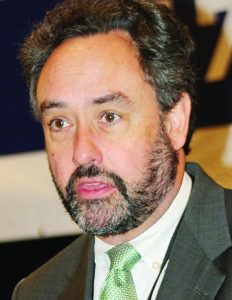
Attorney and scholar David Kopel.
Following the awards luncheon, the afternoon session opened with a discussion on “The Second Amendment Doctrine” with attorney and scholar David Kopel, research director with the Independence Institute.
After providing a history of the Second Amendment, Kopel focused on a Maryland case that resulted in a Fourth Circuit federal court ruling that so-called “assault weapons” are not protected by the Second Amendment.
He noted that nine months after King George ordered an embargo on arms shipments to the colonies in 1774 and the confiscation of arms, the American Revolution began.
Kopel’s presentation was followed by a panel that discussed Winning Firearms Freedom One Lawsuit at a Timent Foundation. Attorney Paloma Capanna with the Second Amendment Coalition Resource Center in New York called the fight over the Second Amendment “the modern civil rights movement.”
She asserted that exercising Second Amendment rights results in giving up other rights. Filling out the federal Form 4473, she suggested, includes an illegal and unconstitutional background check. She encouraged the audience to “stand and fight.”
Attorney Eric Friday with Florida Carry, Inc., questioned the intellectual integrity of some judges in the Sunshine State. He contended that all enumerated rights in Florida deserve strict scrutiny, but some judges apparently believe the right to bear arms is less important than other civil rights.
Sean Maloney, an attorney with the Buckeye Firearms Association and member of the NRA Board of Directors, discussed the situation in Cleveland, where they city has acted in violation of the state preemption statute. As a result, the Ohio Supreme Court ruled against the city and levied a hefty fine.
“When I see a ‘no guns’ sign in a park,” he said, “I ignore it.”
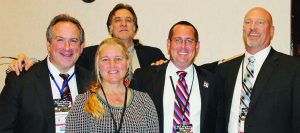
Pro-gun attorney panelists, L to R., Dan Schmutter, Esq., Paloma Capanna, Esq., Don Kilmer, Esq., Eric Friday, Esq., and Sean Maloney, Esq.
Maloney told the audience that everyone should know who their state gun rights organization is, and become active.
Dan Schmutter, legal counsel to the Association of New Jersey Rifle and Pistol Clubs, detailed the dire situation in the Garden State. In New Jersey, he lamented, one cannot lawfully prepare for self-defense in public.
New Jersey is the state where at least one woman was murdered by an ex-boyfriend against whom she had filed a complaint, while she was waiting for approval of a gun permit.
New Jersey courts have decided against people who used alternative weapons in self-defense, including a woman who was being beaten by a boyfriend and a man who had carried a machete in his own home. Still, the state Supreme Court held that the Second Amendment applied to all sorts of weapons, not just firearms, Schmutter reported.
California attorney Don Kilmer detailed how the courts in California have been working. Kilmer has represented SAF in several cases, so he is very familiar with how California courts work, including the federal courts.
There have been some victories in the Golden State, including ones that dealt with zoning ordinances that had been written to prevent gun shop operations.
There are ongoing cases where rulings are pending, and Kilmer told the activist audience that “the fight isn’t over…we have to keep fighting.”
Licensed to Lie
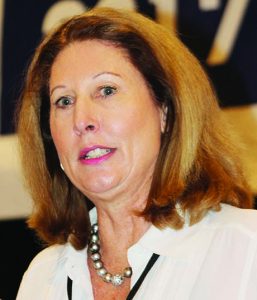
Author and attorney Sidney Powell.
Author-attorney Sidney Powell was back again this year to discuss misconduct by federal prosecutors that has led to cases of injustice against several people, including former Alaska Sen. Ted Stevens.
“The job of a federal prosecutor…is to get it right,” Powell said. “Integrity is an absolute must.”
She is the author of Licensed to Lie: Exposing Corruption in the Department of Justice. It amounts to a damning indictment of the agency and she pulled no punches in her presentation. She used words such as “narcissists” and “egomaniacs” to describe some of the DOJ attorneys who have pursued cases against people like Stevens, along with some companies, resulting in loss of jobs.
“We need to clean out the Department of Justice with Clorox and a fire hose,” Powell asserted.
This concludes Part 1 of our coverage of the 2017 Gun Rights Policy Conference. TGM will wrap up coverage in next month’s issue.



